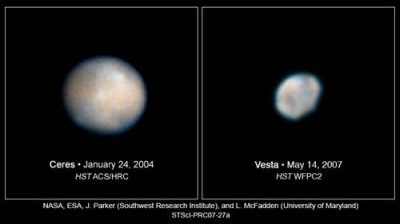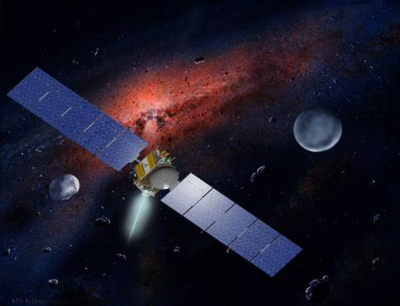27 June 2007

NASA scientists are studying images of the Hubble Space Telescope to plan for the Dawn spacecraft mission, scheduled for launch on 7 July 2007. Dawn's 4-year interplanetary cruise will feature orbiting Ceres (950 km across), the smallest dwarf planet, and Vesta (530 km across), one of the largest asteroids (minor planets).
Dawn is scheduled to arrive at Vesta in 2011 and Ceres in 2015. Both objects orbit the Sun in the asteroid belt, a zone extending between the orbits of Mars and Jupiter, and populated by hundreds of thousands of asteroids. Dawn will be the first spacecraft to visit these two remarkable objects, and the first spacecraft to orbit two objects in one mission.
At least 100,000 asteroids have been cataloged. The asteroids are believed to be primitive objects, leftover from the formation of the Solar System 4.6 billion years ago. Astronomers hope that the Dawn mission would yield valuable clues to the origin and evolution of our planet and the Solar System.

An Artist's Impression of the Dawn Mission
Credit: NASA-JPL
Ceres was discovered by the Italian astronomer Guiseppe Piazzi at the Palermo Observatory in 1801. In Roman mythology, Ceres is the harvest goddess. The discovery of Ceres is one of the most intriguing stories in the history of science.
The Titius-Bode law, formulated in the 1770s, showed that the relative distances of the then known six planets from the Sun fit a mathematical relationship. When the planet Uranus was discovered in 1781, calculations revealed that its distance follows the Titius-Bode formula. Therefore, Titius-Bode law indicated that there was probably an undiscovered planet between Mars and Jupiter.
Astronomers searched for this missing planet in the late 18th century, and Ceres was found to be orbiting the Sun at the distance predicted by the Titius-Bode law. Ceres was initially classified as a planet, but numerous asteroids have been discovered in the asteroid belt ever since. Consequently, Ceres was relegated from its planetary status to become a minor planet till August 2006.
On 24 August 2006, the International Astronomical Union (IAU) devised a new class of Solar System objects, termed "dwarf planets", including Pluto, Eris and Ceres. A dwarf planet is a minor planet which is round in shape.
Further Reading
Hubble Images of Asteroids Help Astronomers Prepare for Spacecraft Visit
http://hubblesite.org/newscenter/archive/releases/2007/27/
Aymen Mohamed Ibrahem
Senior Astronomy Specialist